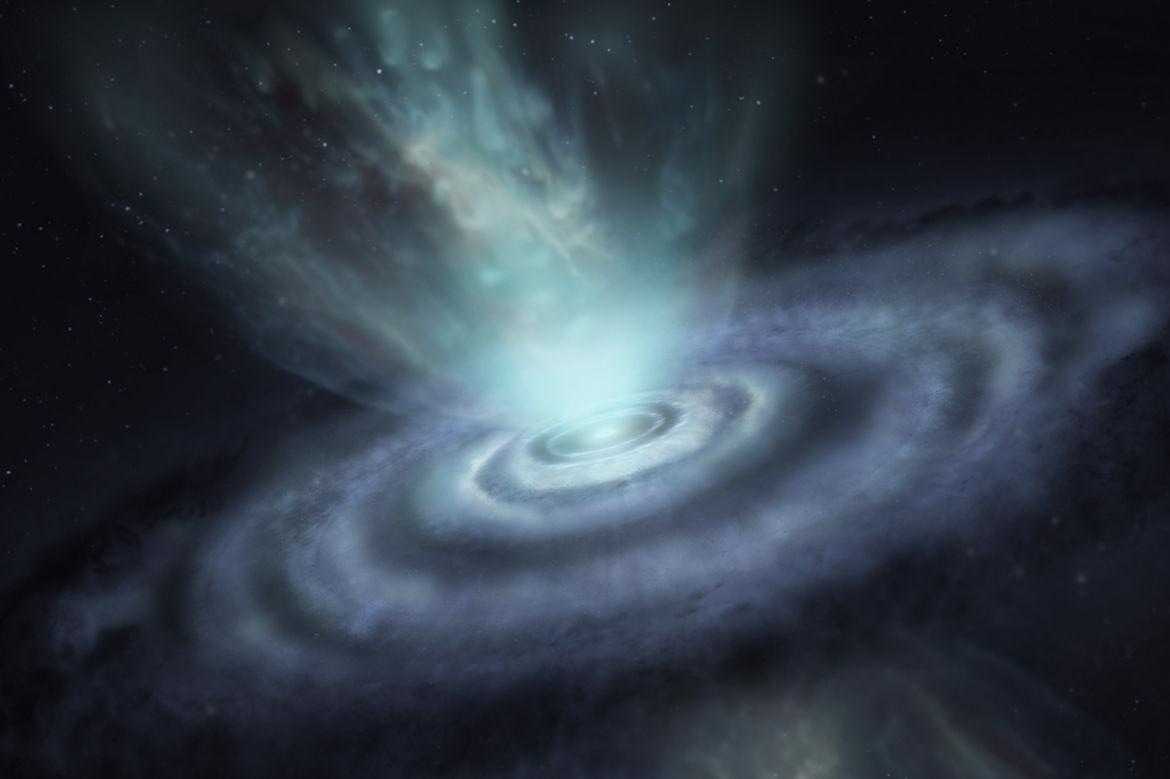Upon examining in extraordinary detail a red gigantic star called V Hydrae—shortened as V Hya—astrophysicists have observed the peculiar death throes of the star.
 A rendering of the star V Hydrae, or V Hya for short. In its death throes, the star has emitted a series of expanding rings that scientists calculated are being formed every few hundred years, said Mark Morris, a UCLA professor of physics and astronomy. Image Credit: ALMA (ESO/NAOJ/NRAO)/S. Dagnello (NRAO/AUI/NSF).
A rendering of the star V Hydrae, or V Hya for short. In its death throes, the star has emitted a series of expanding rings that scientists calculated are being formed every few hundred years, said Mark Morris, a UCLA professor of physics and astronomy. Image Credit: ALMA (ESO/NAOJ/NRAO)/S. Dagnello (NRAO/AUI/NSF).
Scientists from the University of California, Los Angeles (UCLA) and NASA’s Jet Propulsion Laboratory (JPL) learned that the carbon-rich star has ejected six gradually increasing molecular rings and an hourglass-shaped structure expelling matter out into space at great speeds, indicating that the star is experiencing fast evolution as it nears its end in a blaze of glory before stopping its energy generation.
This is the first and only time that a series of expanding rings has been seen around a star that is in its death throes—a series of expanding ‘smoke rings’ that we have calculated are being blown every few hundred years.
Mark Morris, Professor of Physics and Astronomy and Study Co-Author, UCLA
The study’s results, which were achieved using the Atacama Large Millimeter/submillimeter Array (ALMA) and data from the Hubble Space Telescope, have been published in the March 28th issue of the Astrophysical Journal.
Over 90% of stars with a mass the same as or greater than the mass of the sun evolve into what researchers label asymptotic giant branch stars (AGB stars). V Hya is an example of an AGB star. The star is situated about 1,300 light-years from Earth in a constellation called Hydra.
Out of these millions of stars, V Hya has been of specific interest to astronomers because of its distinctive behaviors and features, including very large explosions of plasma that take place about every 8 years and the existence of a virtually invisible companion star that adds to V Hya’s explosive activities.
“We have caught this dying star in the process of shedding its atmosphere—ultimately most of its mass—which is something that most late-stage red giant stars do,” Morris explained. “But much to our surprise, we have found that the matter, in this case, is being expelled as a series of rings.”
Morris said the group also witnessed high-speed explosions of gas, perpendicular to those rings that were ejected into two opposite directions. He suggested that the mechanism that creates the rings is mysterious and will necessitate further study.
We suspect that it might be related to the presence of orbiting companion stars, but it is difficult to explain that given the few-hundred-year interval between ring ejections. This star is providing a new and fascinating wrinkle to our understanding of how stars end their lives.
Mark Morris, Professor of Physics and Astronomy and Study Co-Author, UCLA
Raghvendra Sahai, an astronomer at JPL and the lead author of the study, said the research shows that earlier assumptions about the deaths of stars may be incorrect.
“Our study dramatically reveals that the traditional model of how AGB stars die—through the mass ejection of fuel via a slow, relatively steady, spherical wind over 100,000 years or more—is at best, incomplete, or at worst, incorrect,” he stated.
The six rings that have extended outward from V Hya through approximately 2,100 years have developed a warped, disk-like structure, forming a dust-rich region around the star, the scientists state. The scientists labeled the structure the DUDE (for Disk Undergoing Dynamical Expansion).
V Hya is in the brief but critical transition phase that dying stars go through at the end of their lives. It’s the phase when they lose most of their mass. It’s likely that this phase does not last very long, so it is difficult to catch them in the act. We got lucky with V Hya, and were able to image all of the different activities going on in and around this star to better understand how dying stars lose mass at the end of their lives.
Raghvendra Sahai, Study Lead Author and Astronomer, NASA’s JPL
V Hya’s concluding act has also created an hourglass-shaped structure fixed on the star and arranged perpendicularly to the disk. The hourglass’ two lobes have been formed by a directed, rapid wind that is gusting in two opposite directions at speeds of up to 500,000 miles per hour.
Owing to the large amounts of dust encompassing the star, exploring V Hya needed an exceptional tool with the power to visibly see cold matter that is difficult to see with optical telescopes. ALMA’s receivers are remarkably sensitive to very short radio wavelengths of about 1 mm, which exposed the star’s many rings and outflows of molecular gas in vivid clearness.
The scientists used extra infrared, ultraviolet and optical data to create an extraordinary image of an outstanding show in the galaxy, much of which was unanticipated, Morris explained.
Each time we observe V Hya, it becomes more and more like a circus, with each new evolutionary stage characterized by an even bigger variety of impressive feats. V Hydrae has impressed us with its multiple rings and acts, and because our own sun may one day experience a similar fate, it has us at rapt attention.
Raghvendra Sahai, Study Lead Author and Astronomer, NASA’s JPL
The study was partly funded by NASA and the National Science Foundation.